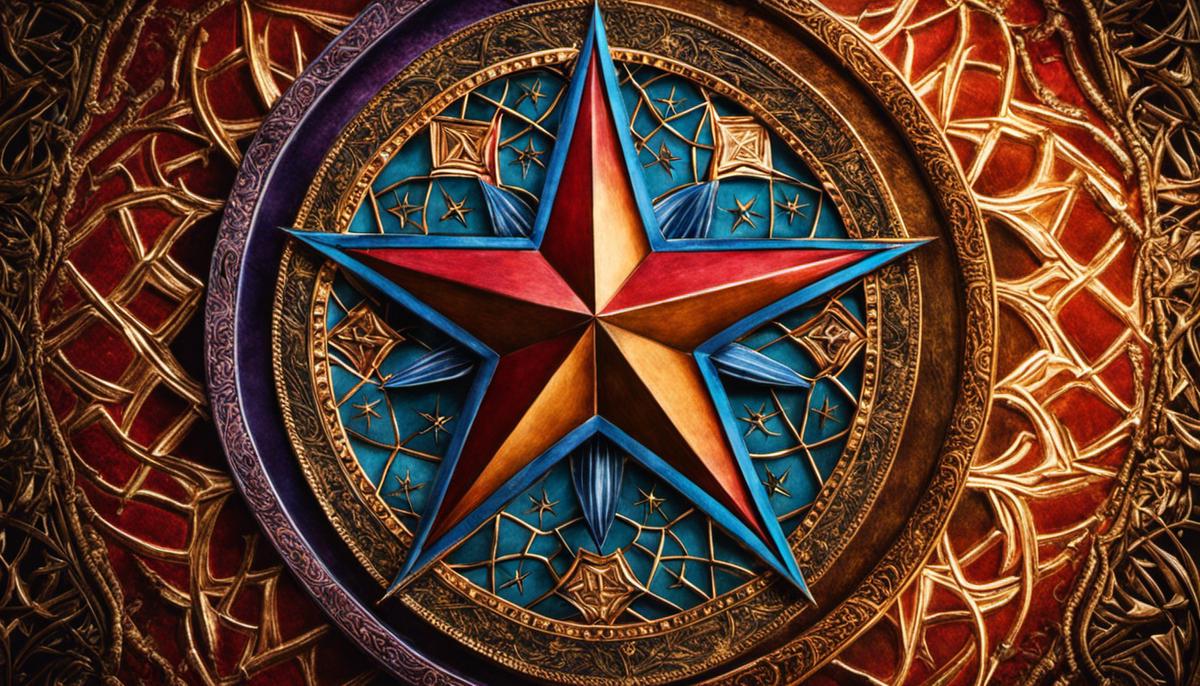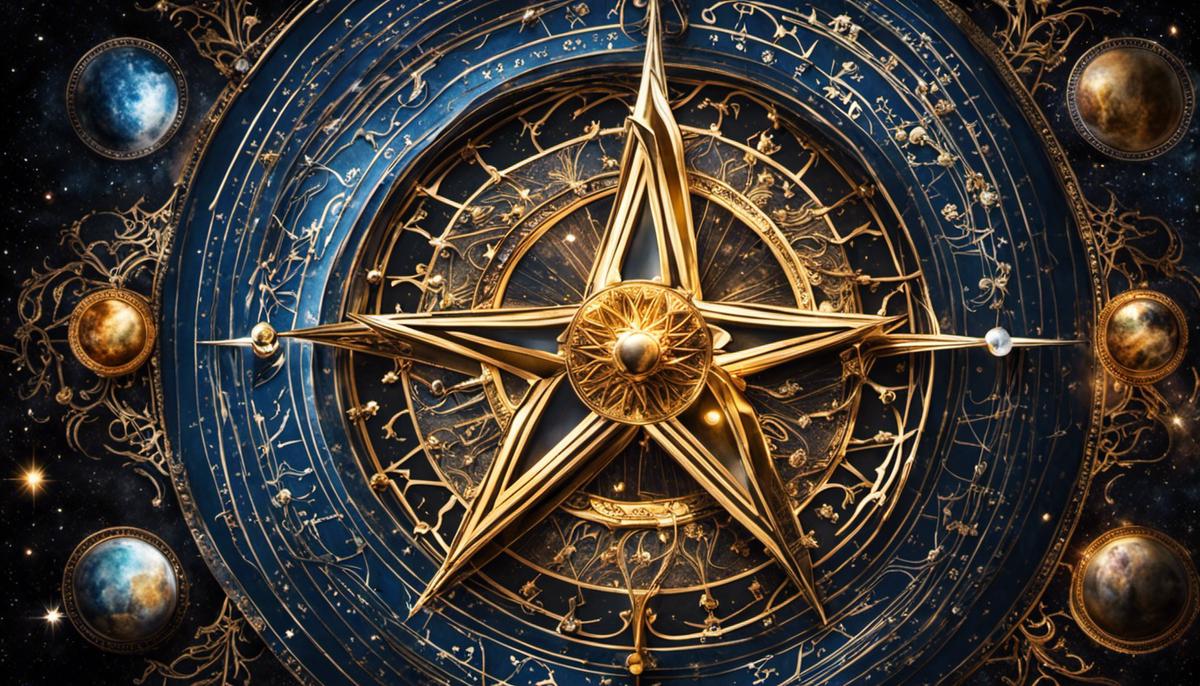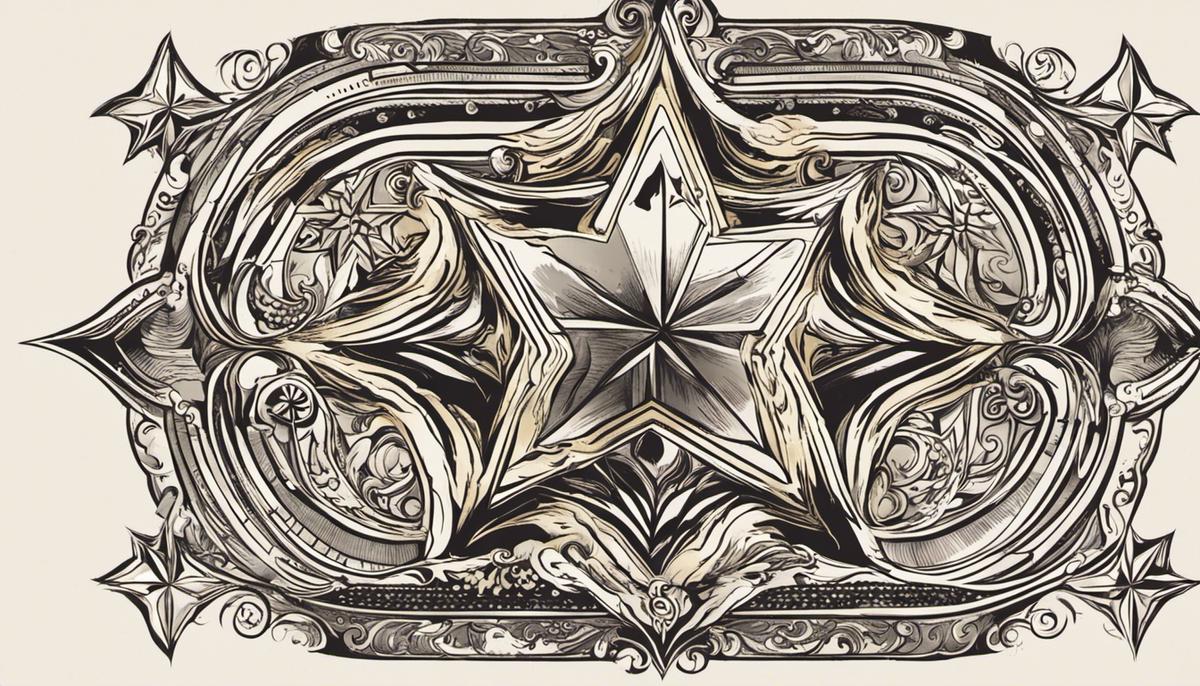Unlocking The Spiritual Meaning of a Five-Pointed Star
The five-pointed star, a symbol with a rich and diverse history, is well-recognized and deeply significant in various cultures, religion, and spiritual practices. The shape, simple but potent, holds multifarious meanings across different eras and civilizations, manifesting in Greek and Roman mythology, Christian symbolism, and varied religious and cultural settings.
Its use transcends the literal and ventures into the arcane domains of magic, occultism, and astrology. Today, the five-pointed star maintains its relevance, resonating considerably in modern spirituality, as well as in meditation and symbolic language practices.
Historical Usage of the Five-Pointed Star

Historical Usage of the Five-Pointed Star in Greek and Roman Mythology
In ancient Greek and Roman mythology, the five-pointed star often referred to as a pentagram held significant symbolic meaning. The Greeks associated it with the five elements—earth, water, air, fire, and spirit, with the latter often represented by the uppermost point. The Pythagoreans, an ancient Greek religious sect, revered the pentagram as a symbol of perfection and health, using it as a salutatory greeting among members.
The Romans, meanwhile, viewed the five-pointed star as a symbol of the goddess Venus. The path that the planet Venus seemingly travels in the sky creates a natural pentagram, leading the Romans to embrace the symbol in honor of the goddess of love and beauty.
The Pentagram in Christianity
The interpretation of the five-pointed star shifts when viewed through the lens of Christian symbolism. Early Christians utilized the pentagram to represent the five wounds of Christ inflicted during the crucifixion. It was seen as a protective amulet against evil. However, in Medieval and Renaissance-period Christianity, the pentagram began to take on negative connotations, often associated with witchcraft and devil worship due to its use in pagan cultures.
The Five-Pointed Star in Other Religions and Cultures
In many other religious and cultural traditions, the five-pointed star held varied spiritual meanings. In Wicca and neo-pagan traditions, it is used in sacred rites and to delineate sacred space. Each point represents an element—air, fire, water, earth, and spirit—emphasizing the interconnectedness of all things.
The Baha’i Faith also incorporates the five-pointed star, known as the “Haykal,” as a symbol of humanity and the five main religions in the world: Judaism, Christianity, Islam, Buddhism, and Hinduism.
The Five-Pointed Star in Modern Times
In more recent times, the five-pointed star maintains a strong presence in a variety of cultural and spiritual contexts. For example, it is used in tarot readings, emblematic of the suit of pentacles, which signifies earth.
It also gained widespread recognition as a national symbol, most notably as a key element in the flag of the United States of America, where each star represents a state in the union.
The spiritual significance of the five-pointed star, known as the pentagram, is universally recognized, intertwining various divine powers, spatial concepts, and spiritual beliefs. Over time, its interpretation may have varied, but a recurring theme appears to be the notion of unity and entirety, seamlessly combining diverse components into a unified whole. It acts as a symbol illustrating the interconnection of everything, emphasizing the boundless potential within the human spirit.
Five-Pointed Star as a Magical or Occult Symbol

Delving Deeper into the Spiritual Significance of the Five-Pointed Star
The pentagram, or the five-pointed star, carries a profound spiritual implication across varying civilizations and historical eras. Being a universally accepted geometrical symbol, it’s pivotal to understand the variety and depth of spiritual beliefs, cosmic perceptions, and divine powers it encapsulates.
The Pentagram in Magic and Occult Practices
In the realm of magic and occultism, the five-pointed star, particularly the pentagram, holds a central position. The symbol is cherished by various pagan religions, especially Wicca, for its magical properties and spiritual associations. Each of the star’s five points is attributed to one of the five classical elements: Earth, Air, Fire, Water, and the fifth point referring to Spirit or Aether.
In occult practices, the orientations of the five-pointed star carry distinct meanings. A star with a single point faced upwards signifies the spirit governing the four classical elements. Conversely, a pentagram with two points upwards is often associated with Satanism as it places the material world over the spiritual one.
The Five-Pointed Star in Wicca
In the Wiccan belief system, the five points of the star represent the interconnectedness of various aspects of life. The single upward point of the pentagram symbolizes the divine, denoting the dominance of spirit over the elements of nature. This orientation is intended to keep evil influences at bay.
A Wiccan pentagram is often inscribed in a circle, which represents the cyclic nature of life and the continuous interplay of the spiritual and physical realms. The symbol also embodies the Wiccan Rule of Three, which states that the energy a person emits into the world, whether good or evil, will return to them threefold.
Symbolic Characteristics and Significance
Beyond its symbolism in paganism, many groups believe that the five-pointed star possesses unique characteristics. The pentagram is seen as a symbol of balance and protection against negative energies. The symbol’s five points reflect the human body’s structure (head, arms, and legs), indicating unity between the human form and the divine cosmos, mind, body, and spirit.
In the field of numerology, five is a dynamic number signifying freedom, adventure, and transformation. As such, the five-pointed star is often associated with these concepts, symbolizing change, growth, and spiritual evolution.
Corresponding Astrology and Tarot Connections
In astrology, the five-pointed star shape is tied to Venus, the planet of love and femininity. As Venus orbits the Sun, it creates a pentagram pattern, further enhancing its spiritual significance.
In the realm of Tarot, the card representing the star symbolizes hope, inspiration, and serenity. It’s often regarded as a beacon of light in the darkness, guiding individuals towards self-discovery and spiritual enlightenment.
The five-pointed star, or the pentagram, is a symbol that bears significant spiritual meaning across various cultures and belief systems. This universally recognized symbol is often associated with an individual’s potential to tap into higher realms, explore the mysteries of existence, and undergo spiritual evolution. Its interpretations may vary, but its role as a powerful spiritual emblem remains unquestioned.
Five-Pointed Star in Astrology and Alchemy

Relationship between the Five-Pointed Star and Astrology
In the realm of astrology, the pentagram carries immense significance. The five points of the pentagram are commonly associated with five classical planets: Mercury, Venus, Mars, Jupiter, and Saturn. Interestingly, Venus holds a special relationship with the five-pointed star due to its singular orbital paths that draw a nearly perfect pentagram in the sky.
Certain astrological beliefs look at the five points of the pentagram as representations of five elements that hail from ancient philosophic traditions. These elements include Earth, Air, Fire, Water, and Ether or Spirit. Astrologers throughout history have sought ways to correlate their celestial observations with these elements, resulting in complex astrological interpretations.
The orbital pattern of Venus, forming a pentagram over an eight-year cycle, is particularly striking. This tie between Venus and the pentagram has expanded the star’s spiritual significance in astrology. It has culminated in the association of the five-pointed star with the concepts of love, beauty, and harmony.
Alchemy and the Five-Pointed Star
In alchemy, the five-pointed star or pentagram often represents the five basic elements of alchemical transformation: Earth, Air, Fire, Water, and Quintessence. These elements are fundamental to the alchemical process, believed to represent different states of matter and aspects of humanity’s spiritual and physical existence.
In a more specific context, some alchemical texts use the pentagram to symbolize the process of transmutation. Each point can signify different stages of transformation, from calcination (fire), dissolution (water), separation (air), conjunction (earth), and fermentation (quintessence or spirit). This transmutation process metaphorically walks through the journey of purifying and realigning the self towards spiritual enlightenment.
More Than a Shape: The Spiritual Significance
Indeed, the five-pointed star isn’t just a geometric figure in these fields. It has a significant spiritual meaning as it is seen as a symbol of balance and protection. The upward point of the star represents the spirit. The other four points all represent an element. Under this perspective, the five-pointed star symbolizes the four earthly elements of fire, air, water, and earth connected or ruled by the spirit.
The star’s point upward also serves as a reminder of the importance of spiritual awareness and the journey towards enlightenment. The symmetry of the pentagram is believed to symbolize harmony, balance, and the interconnectivity of life and the universe.
The five-pointed star, known across multiple spiritual contexts, represents the unity of varying elements. It draws attention to the intricate links between the physical and the spiritual planes, and serves as a constant reminder of our ongoing spiritual journey towards greater knowledge, comprehension, and personal growth.
The Five-Pointed Star in Modern Spirituality

The Pentagram: A Beacon of Equilibrium and Unity
Commonly known as the Pentagram, the five-pointed star occupies a meaningful position in modern spiritual practices. The symbol stands as a testament to the harmony and equilibrium that exist within our lives. Each of its five points symbolizes the quintessential elements of life – earth, air, fire, water, and spirit. These points interconnect to demonstrate the profound interdependence and inseparability of these entities.
Use in Meditation and Healing
In the realm of meditation and healing, the five-pointed star is used as a symbol of protection. Guided meditations often incorporate the visualization of a five-pointed star surrounding the individual or the area to create a sacred and protected space. In practices such as Reiki, the Pentagram might be drawn or visualized over the patient to bolster the healing effect.
Non-Denominational and New-Age Interpretations
In non-denominational spirituality and New-Age beliefs, the five-pointed star symbolizes the quest for Divine Knowledge, the understanding of oneself and the universe. Some see the upward point of the star as a symbol of spirit’s mastery over the four earthly elements.
The human body can also be seen in the five-pointed star, with the head as the upper point and the four limbs representing the other points. This anthropomorphic aspect of the symbol resonates with the goal of holistic spiritual development, tying physical reality with spiritual aspiration.
Symbols in Wicca and Paganism
While misconceptions abound about the Pentagram’s association with dark or satanic rites, in reality, it carries a positive spiritual connotation in many modern traditions. For instance, in Wicca, a modern pagan, witchcraft religion, the symbol represents the feminine energy of the Goddess. The circle often surrounding the star symbolizes the interconnectedness of everything and the cyclical nature of life.
Use in Rituals and Symbolic Language
The five-pointed star holds an essential position in rituals and symbolic language tied to modern spirituality. Its positioning, either point up or down, can convey distinctive meanings. An upward-pointing star is generally associated with positive, spiritual affirmations, while a downward-facing one might correspond, in some beliefs, to a focus on the material or physical world.
Throughout modern spirituality, the enduring symbolism of the five-pointed star serves as a reminder of universal interconnectedness and the pursuit of spiritual wisdom. It continues to be a potent symbol of protection, balance, and harmony in spiritual rituals and meditation practices today.

As explored, the five-pointed star pervades humanity’s spiritual journey, illuminating various paths from the physical to the metaphysical domain. It transitions from a historical emblem observed in mythology and religious symbolism to an occult and astrological symbol, reverberating through the ages to remain pertinent in modern spirituality.
Undeniably, this multifaceted symbol transcends its geometric simplicity to embolden rich interpretation and profound meaning. Thus, it stands as a remarkable testament to the human propensity for wonder, exploration, and contemplation, continuing to shine brightly in our collective spiritual consciousness.





